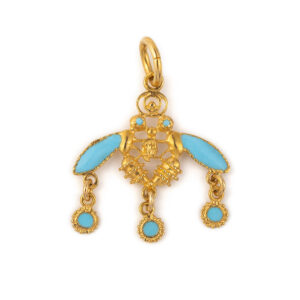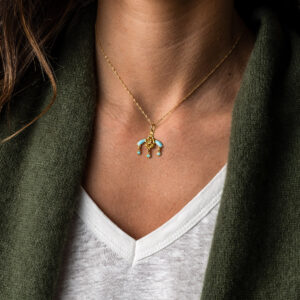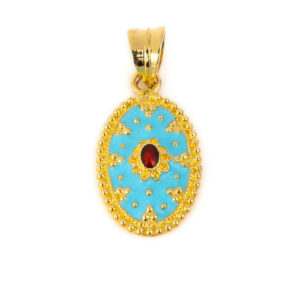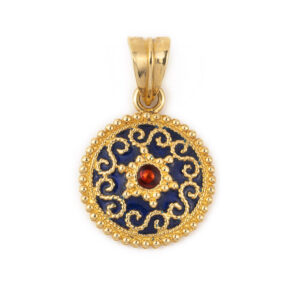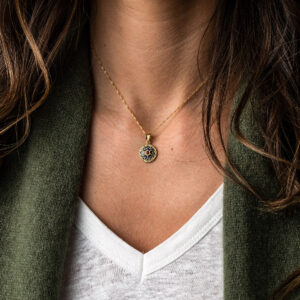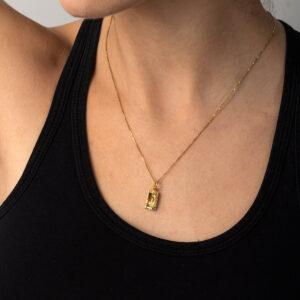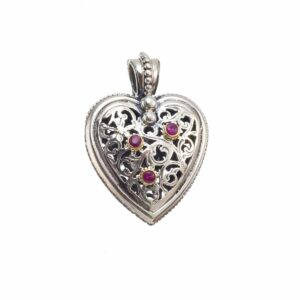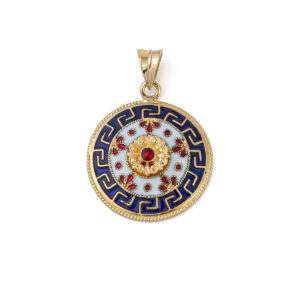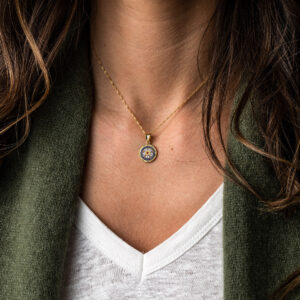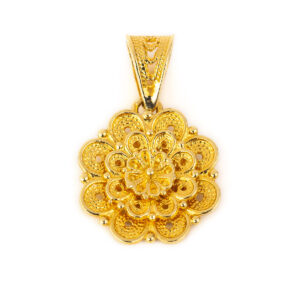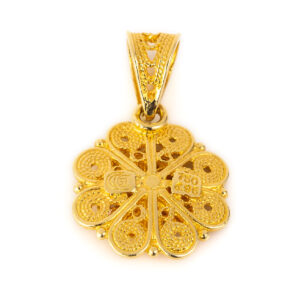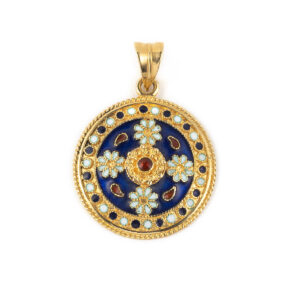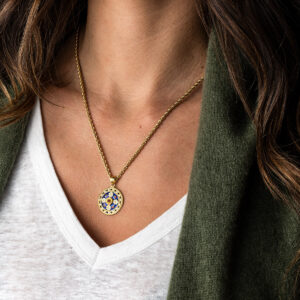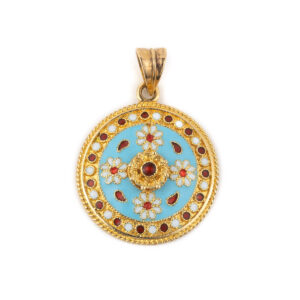Pendants
18k Yellow Gold Minoan Bee Pendant
330,00€This pendant is made in 18k yellow gold with turquoise/ blue enamel inspired by the Minoan Bee Pendant. The Malia honeybee pendant was discovered at Chryssolakkos, of the Minoan Palace of Malia on the island of Crete, and is thought to date to c.1800 BC. The named Chryssolakkos that means the “pit of gold” because of the precious objects that the farmers used to find there. The Minoan Palace is situated 3 km east of Malia town and is the third most significant known Minoan Palace after Knossos and Phaistos.
This pendant is in the shape of two bees, or wasps, storing away a drop of honey in a comb and is one of the most famous exhibits in the Herakleion Museum.
Handmade item.
The chain shown in the third picture is our 14k Gold Twisted Chain (not included).
18K Gold and Turquoise Enamel Pendant
528,00€Byzantine pendant embellished with turquoise enamel and granules of precious metal.
Handmade with great attention to detail. Inspired by Byzantine art.
Made in 18k gold
Granulation (from Latin: granum = “grain”) is a jewellery technique whereby a surface of a jewel is covered with small spheres or granules of precious metal. The technique is thought to have its origins in Mesopotamia about 5,000 years ago.
18k Solid Gold Round Pendant with Blue and Red enamel
462,00€Ancient Greek Round Pendant with blue and red enamel and granules of precious metal. The back side of the pendant has no decoration.
Design inspired by the incredible beauty of historical tradition.
Made in 18k yellow gold.
The chain shown is our 14K Gold Chain in Length 40cm (not included).
Also available with turquoise enamel
Handmade item.
This technique is called Granulation. Granulation (from Latin: granum = “grain”) is a jewellery technique whereby a surface of a jewel is covered with small spheres or granules of precious metal. The technique is thought to have its origins in Mesopotamia about 5,000 years ago. As in all handmade items, there may be small differences in weight and dimensions and this is what makes them unique and precious.
Parthenon Temple Charm Pendant – 18k Gold
440,00€ – 1.344,00€Yellow gold charm depicts the monument of the Parthenon, the main monument in Acropolis. Built in honor of the goddess Athena, and is the brightest monument of the Athenian.
Used as a charm on a bracelet or as a pendant on a chain.
Available in 3 sizes.
Made in 18k yellow gold.
Handmade item.
14K Gold Box Chain in Length 50cm (not included).
Gerochristo – Garden Shadows Heart pendant in 18K Gold and Sterling Silver with rubies
487,00€Heart pendant, decorated with filigree, handcrafted with the finest attention to detail.
Embrace elegance with the Garden Shadows medium Heart pendant in 18K Gold and Sterling Silver with rubies. This exquisite pendant, featuring a striking heart motif, symbolizes love and is perfect for those who appreciate the finer things in life.
The pendant boasts elegant details, enhancing its overall allure.
Ideal for special occasions, as a gift of love.
Handcrafted jewelry made in Greece.
Explore Valentine Collection by Gerochristo
18k Solid Gold Greek Key Pendant with Blue enamel
1.275,00€Ancient Greek Round Pendant with blue enamel. The back side of the pendant has no decoration.
Design inspired by the incredible beauty of historical tradition.
Made in 18k yellow gold.
The chain shown is our 14K Gold Twisted Chain in Length 40cm (not included).
Handmade item.
Explore Byzantine Collection
18K Gold Filigree Byzantine Rosette Pendant
572,00€Byzantine pendant which have the shape of a flower rosette.
This pendant is embellished with a fine filigree and granules of precious metal.
Handmade with great attention to detail. Inspired by Byzantine art.
Made in 18k gold
Rosette flower
The rosette (rose) is a timeless jewel, symbol and amulet. The origin of the term is the Greek word for rose – rodon (ρόδον). Its use began in the Mycenaean era and continues as far as the 2nd millennia BC. The Mycenaean Rosette is a motif that was widespread throughout Mesopotamia, Egypt, Greece and other ancient civilizations. It is inspired by a Mycenaean rosette bead, found at Mycenae, dated to 1400-1300 B.C. The rosette was used extensively in ancient Greek Mycenaean jewels, in architecture, pottery and in sculptures from 1500 BC. Mycenaean rosettes usually had 6 or 8 or 12 leaves, and sixteen leaves during the Macedonian Dynasty. Such details as the rodax shape and the number of leaves tend to vary with the era or beliefs. The rosettes were used to decorate the cloths, belts and wreaths of the Kings. The number of leaves had a symbolic character each time. The four elements of nature (wind, earth, fire, water), the seven wonders of the ancient world or the twelve gods of ancient Greeks and the world domination and radiance of the Kings of Macedonia. They were signs of beauty, purity, eugenics, worship and power. Rosette or Rodax was probably the most popular and favorite decorative element in Mycenaean era, classical antiquity and Byzantine times.
Granulation (from Latin: granum = “grain”) is a jewellery technique whereby a surface of a jewel is covered with small spheres or granules of precious metal. The technique is thought to have its origins in Mesopotamia about 5,000 years ago.
Filigree is a delicate kind of jewellery metalwork, made with tiny beads or twisted threads, or both in combination, soldered together or to the surface of an object of the same metal and arranged in artistic motifs. The art of filigree dates back to ancient history. The first of the found jewelry in this technique has been found in Mesopotamia and dates to thousands of years BC. In the ancient world and particularly in Asia Minor, this art grew at the highest level.
18k Gold Blue Ancient Greek Floral Pendant
1.197,00€Ancient Greek Round Pendant with floral motif (four rosette motifs). The pendant is decorated with blue & red enamel and granules of precious metal. The back side of the pendant has no decoration.
Design inspired by the incredible beauty of historical tradition.
Made in 18k yellow gold
Also available with turquoise enamel
Handmade item.
The chain shown is our 14K Gold Rope Chain (not included).
This technique is called Granulation. Granulation (from Latin: granum = “grain”) is a jewellery technique whereby a surface of a jewel is covered with small spheres or granules of precious metal. The technique is thought to have its origins in Mesopotamia about 5,000 years ago.
The rosette (rose) is a timeless jewel, symbol and amulet. The origin of the term is the Greek word for rose – rodon (ρόδον). Its use began in the Mycenaean era and continues as far as the 2nd millennia BC. The Mycenaean Rosette is a motif that was widespread throughout Mesopotamia, Egypt, Greece and other ancient civilizations. It is inspired by a Mycenaean rosette bead, found at Mycenae, dated to 1400-1300 B.C. The rosette was used extensively in ancient Greek Mycenaean jewels, in architecture, pottery and in sculptures from 1500 BC. Mycenaean rosettes usually had 6 or 8 or 12 leaves, and sixteen leaves during the Macedonian Dynasty. Such details as the rodax shape and the number of leaves tend to vary with the era or beliefs. The rosettes were used to decorate the cloths, belts and wreaths of the Kings. The number of leaves had a symbolic character each time. The four elements of nature (wind, earth, fire, water), the seven wonders of the ancient world or the twelve gods of ancient Greeks and the world domination and radiance of the Kings of Macedonia. They were signs of beauty, purity, eugenics, worship and power. Rosette or Rodax was probably the most popular and favorite decorative element in Mycenaean era, classical antiquity and Byzantine times.
18k Gold Ancient Greek Round Floral Rosette Pendant
1.197,00€Ancient Greek Round Pendant with floral motif (four rosette motifs). The pendant is decorated with turquoise & red enamel and granules of precious metal. The back side of the pendant has no decoration.
Design inspired by the incredible beauty of historical tradition.
Made in 18k yellow gold
Also available with blue enamel
Handmade item.
The chain shown is our 14K Gold Rope Chain (not included).
This technique is called Granulation. Granulation (from Latin: granum = “grain”) is a jewellery technique whereby a surface of a jewel is covered with small spheres or granules of precious metal. The technique is thought to have its origins in Mesopotamia about 5,000 years ago.
The rosette (rose) is a timeless jewel, symbol and amulet. The origin of the term is the Greek word for rose – rodon (ρόδον). Its use began in the Mycenaean era and continues as far as the 2nd millennia BC. The Mycenaean Rosette is a motif that was widespread throughout Mesopotamia, Egypt, Greece and other ancient civilizations. It is inspired by a Mycenaean rosette bead, found at Mycenae, dated to 1400-1300 B.C. The rosette was used extensively in ancient Greek Mycenaean jewels, in architecture, pottery and in sculptures from 1500 BC. Mycenaean rosettes usually had 6 or 8 or 12 leaves, and sixteen leaves during the Macedonian Dynasty. Such details as the rodax shape and the number of leaves tend to vary with the era or beliefs. The rosettes were used to decorate the cloths, belts and wreaths of the Kings. The number of leaves had a symbolic character each time. The four elements of nature (wind, earth, fire, water), the seven wonders of the ancient world or the twelve gods of ancient Greeks and the world domination and radiance of the Kings of Macedonia. They were signs of beauty, purity, eugenics, worship and power. Rosette or Rodax was probably the most popular and favorite decorative element in Mycenaean era, classical antiquity and Byzantine times.

